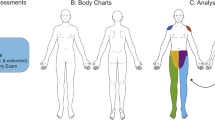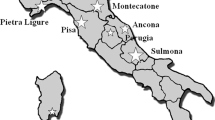Abstract
Study design:
Prospective cohort.
Objectives:
To characterize spinal cord injury (SCI)-related pain and treatment in victims of the 2008 Sichuan earthquake.
Setting:
Mianzhu County, China.
Methods:
Twenty-six patients who sustained SCI in the 2008 Sichuan earthquake and who were treated in the same hospital were enrolled. Data was collected on pain severity with a visual analog scale, depression with Patient Health Questionnaire-9, quality of life (QoL) with World Health Organization Quality of Life-BREF and social participation with the Craig Hospital Handicap Assessment and Reporting Technique Short Form at three assessment points. Detailed pain descriptions including therapeutic interventions were elicited at the fourth assessment. Pain determinants were analyzed with a longitudinal Tobit regression, and Pearson’s correlations of pain severity with depression, QoL and social participation stratified by measurement point were calculated.
Results:
SCI-related pain was highly prevalent and prevalence of neuropathic pain was nearly twice that of nociceptive pain. Most patients reported pain since the onset and severity was not significantly reduced over time. Cervical injury, complete lesions and education level were significant pain determinants. Depression and QoL scores were highly correlated with pain at the first two assessments points but not at the third measurement. Most patients did not seek treatment because they regarded pain as either a normal condition after SCI or were afraid of drug dependency.
Conclusion:
This initial longitudinal assessment and characterization of SCI-related pain in earthquake victims provides a foundation for further exploration of the biological and psychosocial determinants of pain severity and of the correlation of chronic pain with other outcomes of interest in this population. Patient pain-treatment-seeking behavior and therapeutic interventions should be evaluated concurrently.
Similar content being viewed by others
Log in or create a free account to read this content
Gain free access to this article, as well as selected content from this journal and more on nature.com
or
References
Zhang X, Reinhardt JD, Gosney JE, Li J . The NHV rehabilitation services program improves long-term physical functioning in survivors of the 2008 Sichuan earthquake: a longitudinal quasi experiment. PLoS One 2013; 8: e53995.
Yongqiang Li, Reinhardt JD, Gosney JE, Zhang X, Hu X, Chen S et al. Evaluation of functional outcomes of physcial rehabilitation and medical complications in spinal cord injury victims of the Sichuan earthquake. J Rehabil Med 2012; 44: 534–540.
Loeser JD, Treede RD . The Kyoto protocol of IASP basic pain terminology. Pain 2008; 137: 473–477.
Dijkers M, Bryce T, Zanca J . Prevalence of chronic pain after traumatic spinal cord injury: a systematic review. J Rehabil Res Dev 2009; 46: 13–29.
Bryce TN, Biering-Sorensen F, Finnerup NB, Cardenas DD, Defrin R, Lundeberg T et al. International spinal cord injury pain classification: part I. Background and description. March 6-7, 2009. Spinal Cord 2012; 50: 413–417.
Boonstra AM, Schiphorst Preuper HR, Reneman MF, Posthumus JB, Stewart RE . Reliability and validity of the visual analogue scale for disability in patients with chronic musculoskeletal pain. Int J Rehabil Res 2008; 31: 165–169.
Leung SO, Chan CC, Shah S . Development of a Chinese version of the Modified Barthel Index— validity and reliability. Clin Rehabil 2007; 21: 912–922.
Walker N, Mellick D, Brooks CA, Whiteneck GG . Measuring participation across impairment groups using the Craig Handicap Assessment Reporting Technique. Am J Phys Med Rehabil 2003; 82: 936–941.
Jang Y, Hsieh CL, Wang YH, Wu YH . A validity study of the WHOQOL-BREF assessment in persons with traumatic spinal cord injury. Arch Phys Med Rehabil 2004; 85: 1890–1895.
Bombardier CH, Kalpakjian CZ, Graves DE, Dyer JR, Tate DG, Fann JR . Validity of the Patient Health Questionnaire-9 in assessing major depressive disorder during inpatient spinal cord injury rehabilitation. Arch Phys Med Rehabil 2012; 93: 1838–1845.
Celik EC, Erhan B, Lakse E . The clinical characteristics of neuropathic pain in patients with spinal cord injury. Spinal Cord 2012; 50: 585–589.
Widerstrom-Noga E, Biering-Sorensen F, Bryce T, Cardenas DD, Finnerup NB, Jensen MP et al. The international spinal cord injury pain basic data set. Spinal Cord 2008; 46: 818–823.
Li J, Feng Y, Han J . Linguistic adaptation into Chinese and multicentered validation of three questionnaires for the screening of neuropathic pain. Chinese J Pain Med 2011; 17: 9.
Twisk J, Rijmen F . Longitudinal tobit regression: a new approach to analyze outcome variables with floor or ceiling effects. J Clin Epidemiol 2009; 62: 953–958.
Efron B, Tibshirani R . Bootstrap methods for standard errors, confidence intervals, and other measures of statistical accuracy. Stat Sci 1986; 1: 54–75.
Siddall PJ, McClelland JM, Rutkowski SB, Cousins MJ . A longitudinal study of the prevalence and characteristics of pain in the first 5 years following spinal cord injury. Pain 2003; 103: 249–257.
Dionne CE, Von Korff M, Koepsell TD, Deyo RA, Barlow WE, Checkoway H . Formal education and back pain: a review. J Epidemiol Commun Health 2001; 55: 455–468.
Heutink M, Post MW, Bongers-Janssen HM, Dijkstra CA, Snoek GJ, Spijkerman DC et al. The CONECSI trial: results of a randomized controlled trial of a multidisciplinary cognitive behavioral program for coping with chronic neuropathic pain after spinal cord injury. Pain 2012; 153: 120–128.
Hoffman JM, Bombardier CH, Graves DE, Kalpakjian CZ, Krause JS . A longitudinal study of depression from 1 to 5 years after spinal cord injury. Arch Phys Med Rehabil 2011; 92: 411–418.
Heutink M, Post MW, Wollaars MM, van Asbeck FW . Chronic spinal cord injury pain: pharmacological and non-pharmacological treatments and treatment effectiveness. Disabil Rehabil 2011; 33: 433–440.
Norrbrink C, Lindberg T, Wahman K, Bjerkefors A . Effects of an exercise programme on musculoskeletal and neuropathic pain after spinal cord injury: results from a seated double-poling ergometer study. Spinal Cord 2012; 50: 457–461.
Norrbrink C, Lundeberg T . Acupuncture and massage therapy for neuropathic pain following spinal cord injury: an exploratory study. Acupunct Med 2011; 29: 108–115.
Cork RC, Isaac I, Elsharydah A, Saleemi S, Zavisca F, Alexander L . A comparison of the verbal rating scale and the visual analog scale for pain assessment. Int J Anesthesiol 2004; 8.
Acknowledgements
We graciously thank the earthquake victims and rehabilitation volunteers who participated in this study. The outstanding work of volunteers Sijing Chen, Xiaorong Hu, Chengjie Yan and Shouguo Liu is especially acknowledged. We are also grateful for the generous support of the Caring For Children Foundation (Hong Kong), Handicap International and the Mianzhu Hospital. The work of Drs Wen and Zhang has been funded by the Caring for Children Foundation, Hong Kong, China. Dr Raouf Gharbo of the International Society of Phyical and Rehabilitation Medical Committee for Rehabilitation Disaster Relief (Physicians for Peace) is kindly acknowledged for his expert technical review.
Author information
Authors and Affiliations
Corresponding author
Ethics declarations
Competing interests
The authors declare no conflict of interest.
Additional information
Disclaimer
This institution had at no time any influence on the analysis or interpretation of the data nor on drafting the manuscript.
Rights and permissions
About this article
Cite this article
Wen, H., Reinhardt, J., Gosney, J. et al. Spinal cord injury-related chronic pain in victims of the 2008 Sichuan earthquake: a prospective cohort study. Spinal Cord 51, 857–862 (2013). https://doi.org/10.1038/sc.2013.59
Received:
Revised:
Accepted:
Published:
Issue date:
DOI: https://doi.org/10.1038/sc.2013.59



